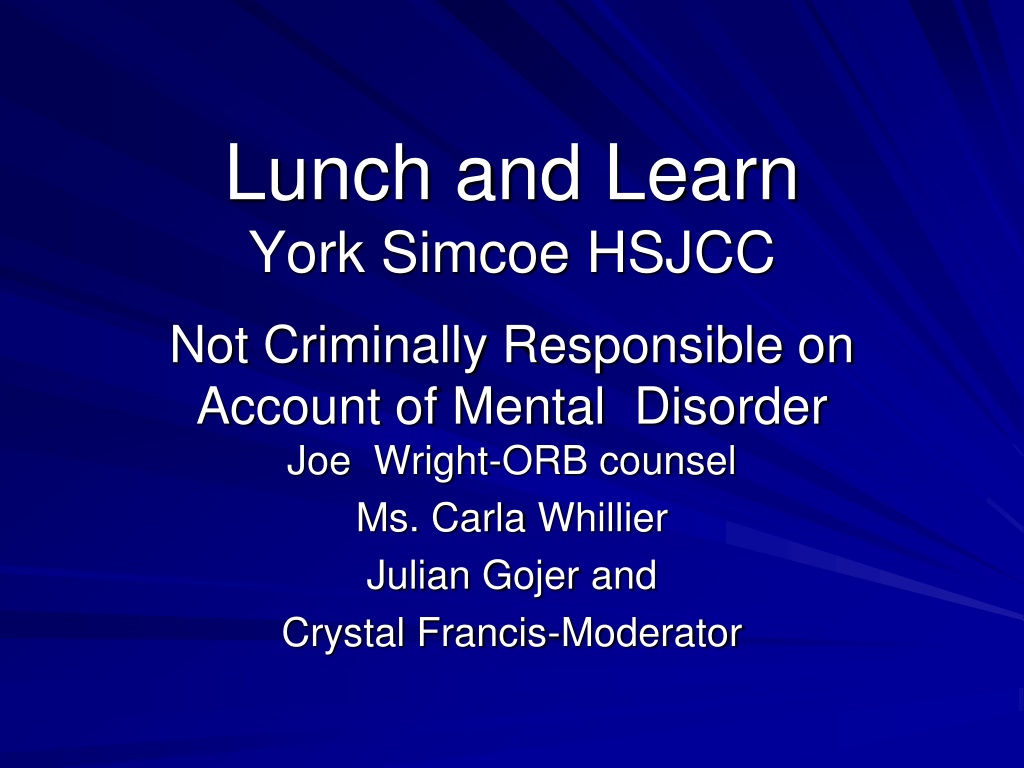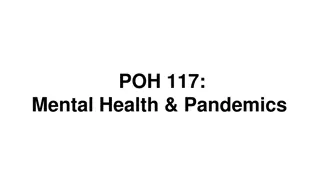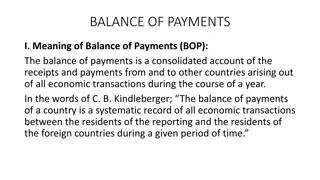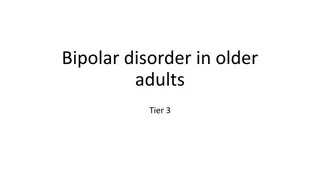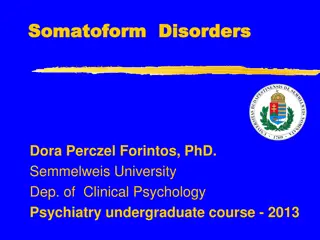Understanding Not Criminally Responsible on Account of Mental Disorder
Explore the intricacies of NCRMD, from the legal framework to practical implications, through insightful presentations and discussions. Delve into the criteria, expert testimonies, and statistics surrounding cases of NCR to gain a comprehensive understanding of this complex issue.
Download Presentation

Please find below an Image/Link to download the presentation.
The content on the website is provided AS IS for your information and personal use only. It may not be sold, licensed, or shared on other websites without obtaining consent from the author. Download presentation by click this link. If you encounter any issues during the download, it is possible that the publisher has removed the file from their server.
E N D
Presentation Transcript
Lunch and Learn York Simcoe HSJCC Not Criminally Responsible on Account of Mental Disorder Joe Wright-ORB counsel Ms. Carla Whillier Julian Gojer and Crystal Francis-Moderator
Not Criminally Responsible On Account of Mental Disorder and What Lies Beyond Dr. Julian Gojer MBBS FRCPC JD Assistant Professor of Psychiatry University of Toronto
What is mind? No Matter! What is matter? Never mind!
NCRMD-Section 16 Suffering from a Mental Disorder Act or omission Renders person incapable of: Appreciating nature and quality of act/omission Knowing that it was wrong Moral and not legal wrongfulness Note: The Incapacity is on the Balance of Probability and The onus is on the person who raises the defense
Not a Metaphor for Freedom Old wine in new bottle-Insanity to NCRMD Get out of jail free ticket Get into hospital for a long time Get medicated against your wishes if not capable of consenting to treatment Shifting focus from mental illness to dangerousness
Of All NCR Cases Homicide 2.6% Attempt murder 3.3% Sexual assault 2.1% All violent cases-8% Women 15% About 30 % of violent cases-psychotic About 60 % more than 1 diagnosiss About 25% with personality disorders About 10% of violent cases reoffend
Using an Expert To highlight the defense at the outset To rebut a finding already made The need to look at timing and Who brings the application? Before a finding of guilt is made-Defense After it is established by the court that the accused committed the act-Crown or defense Crown cannot raise NCR until a finding of guilt is made.
What Expert to Use? Often a psychiatrist Less often a psychologist Psychiatrist-medical background and mental health expertise Psychologist-Non medical background The introduction of such evidence is governed by the rules set out in R v Mohan in Canada. Similar rules are there in the US and the tests laid out in Daubert v Merrell Dow.
Who to Choose? Nature of the offense Experience of the expert Qualifications of the expert Location of the assessment R v Palmer R v Lapierre
Experts May include General psychiatrist, Forensic psychiatrist, Psychiatrist in forensic practice, Neuropsychiatrist Sleep specialist Psychologist, neuropsychologist, educational psychologist Neurologist Criminologist Social worker Addiction specialist, Toxicologist Others Importance of looking at biological, psychological and social factors in explaining mental disorder
NCR assessment and Beyond? Fitness to stand trial R v Wagman Capacity to make a voluntary statement Criminal Responsibility Diminished Capacity To provide a narrative and give context to an offense Sentencing and Risk Assessments-R v Fortune
Mens Rea ALI s degrees of Mens Rea: Purposefulness-acting with the conscious purpose to engage in specific conduct or to cause a specific result. Knowledge-awareness that one s conduct is of a particular nature and will lead to a specific result Recklessness-conscious disregard for a substantial and unjustified risk Negligence-creation of a substantial or known risk of which one ought to have been aware
The Actus Reus Whether the act was voluntary or not? Was there impairment of consciousness? Was the volitional capacity of the individual overwhelmed? Justice Lamer in Swain (1991) said: Sometimes the boundary between mens rea and actus reus can be blurred. Automatisms-Negation of Actus Reus
It is clear that offending lies on a spectrum of culpability and no two offenders have the same developmental background to their offending. If a sentence is to befit the crime then understanding the degree of culpability is extremely important Minimum sentences and lack of a clear diminished capacity defense in Canadian law precludes a nuanced fault level and commensurate sentences
The Many Faces of Mental Illness DSM 5 has distinct categories The boundaries between disorders is often blurred Reconceptualization of psychiatric disorders, new conditions are listed and some are dropped. Unlike general medicine, many of the disorders do not have a specific etiology Disorders are at best syndromes Many of them lie on a spectrum of quantity and quality of signs and symptom clusters.
What is a Mental Disorder? The court decides based on medical input and policy reasons what a Mental Disorder is. Internal external dichotomy Continuing danger Dangerousness as the new determination!
Diagnosis v signs and symptoms Diagnosis is important for establishing Mental Disorder Signs and Symptoms go towards capacity
The analysis of appreciation of the nature and quality of one s actions and consequences and their moral wrongfulness requires a very careful analysis of signs and symptoms that contribute to the diagnosis and which become more important than the actual diagnosis for the final legal determination. The above tests are couched in language where the analysis ends in how signs and symptoms impact on cognitive capacity or the decision making process of the individual. The analysis has to be both quantitative and qualitative. The quantitative aspects can go both to addressing mens rea and actus reus and the NCRMD analysis The qualitative analysis goes to the heart of the NCRMD assessment
Analyzing an Assessment Report Timing of the assessment-R v Luedecke Sources of information Clear understanding of the allegations Clear documentation of onset of signs and symptoms Description of signs and symptoms Impact of signs and symptoms on behavior related to and unrelated to offense Do symptoms add up to a recognizable disorder Has malingering been considered Role of drugs and alcohol How does it impact on capacity
Capacity Examination of mental state at the material time to determine: Level of alertness Level of altered consciousness Level of disconnect between consciousness and action-automatism Degree of planning and deliberation Foresee the consequences of actions Weigh the pros and cons of actions Exercise rational choice Role of emotional state and impact on thinking
Signs, Symptoms, Disorders Intoxication or withdrawal Delusions and or Hallucinations Manic/depressive/anxiety/fear/anger symptoms Dissociative symptoms Memory problems Impulse Control (clarify irresistible impulse) Brain damage-frontal lobe and other Seizure disorders Intellectual limitation Personality Disorders-antisocial, borderline, etc Other non psychotic disorders-OCD Other medical conditions-diabetes etc
Diminished Capacity Not available in Scottish and Belgium Law Available in some US states Available in England, Holland, Norway, Germany and Japan Not available formally in Canadian Law But a closer examination of the Criminal Code and case law suggests otherwise.
One understanding of diminished culpability secondary to diminished capacity is seen when addressing the negation of specific Intent. The test is a cognitive test: Lack of foreseeability of the consequences of one s actions.
Foreseeability A complex cognitive function Intellectual functioning necessary but not sufficient Some degree of abstract thought process needed Some degree of attention Some degree of awareness Role of intense emotions like rage, fear, depression or mania
Intoxication and Withdrawal DPP v Beard 1920 and R v Bernard 1988 Degrees of intoxication-Daley Mild-no impact on mens rea Advanced-can negate specific intent Extreme-can lead to automatism So intoxicated that he could not reasonably foresee the consequences of his actions-Daley Drug induced psychosis-Cooper 1980 Stone 1999 and Lebrun-Bouchard 2011 R v Payan Drug addiction as a possible mechanism for NCRMD
Drug Induced Psychosis R v Ballamekongo Charged with murdering landlady LSD induced mental disorder Both NCR and Diminished Capacity available Defense chooses diminished capacity
Infanticide Does not follow medical understanding of post partum period and in the absence of an NCRMD defense, infanticide as a defense indicates that the offense falls short in terms of culpability for murder - R v Brazalot
Duress Criminal act is carried out under a compulsion Le Bel in Ruzic 2001 highlights the subjective and objective nature of the test. Understanding psychiatric symptoms irrespective of what the diagnosis is becomes important in understanding impact of duress on otherwise criminal behavior.
Self Defense The test has an objective and a subjective component and psychiatric testimony with respect to dynamics and interplay of psychiatric symptoms and psychological nuances on the offending. R v Lavalle 1990 R v Petel 1994 The accused must be found to have subjectively believed that the infliction of grievous bodily harm or death was the only way to protect herself, no other viable alternative should be present, there should be reasonable and probable grounds for the actions Klimovich and Lasota Batter boy syndrome, Battered prisoner syndrome
Provocation A wrongful act or insult aimed at someone, the nature of which is sufficient enough to deprive an ordinary person of the powers of self control R v Carpenter 1993. R v Hill 1986 A subjective component in that the act should occur before the accused s passion cooled. R v Hill. R v Poland, R v Choudhury R v Parent: anger by itself not a defense
Mental Illness and Diminished Capacity Ballamekongo-drug induced mental illness Battered Boy Syndrome Dupe-mental illness, intoxication, personality disorder, trauma, malingering. First to Second degree murder. Klimovich-Major depression, dissociation, provocation
R v Klimovich Jewish man separated from non Jewish wife, but still living with her Severe depression-major depression and dissociative episodes Claimed she called him a Jewish rag and she attacked him with a knife Court ordered assessment-not meeting NCRMD Testimony by psychiatrist Self defense, provocation, murder Manslaughter-verdict Both sides appealing
R v Ching 55 year old man. Long history of depression and on antidepressants. Abusive to wife who leaves him More depressed, Takes overdose and discharged without medication. Depressive psychosis Buys hatchet and knife a few days later and goes to wife s uncle house where wife is staying Asks her to come out to talk to him. Uncle at door Good relationship and was asked to leave pushes in past the uncle. Scuffle ensues. Uncle stabbed in stomach and succumbs. Seen standing with a dazed look. No attempt to run away. First degree murder Testimony by two psychiatrists. Issues of Murder, Manslaughter and NCR raised. Jury finds him guilty of first degree murder
R v Jacquard [1997] SCC Sopinka, Cory and Major dissenting: the trial judge fully explained the relevance and application of the psychiatric evidence to the issue of mental disorder under section 16 of the CC. He also specifically referred to this evidence in relation to other issues but he did not do so in relation to the charge on planning and deliberation. The jury might well have taken from this that the mental disorder evidence and the psychiatric evidence in particular were only relevant in respect of those issues to which a specific reference was made. Furthermore, a simple reference may not have been adequate in this case since it is uncertain that a jury, without a proper instruction, would know how the psychiatric evidence, couched in terms of s.16, would apply to planning and deliberation.
R v Allard [1990] Quebec Court of Appeal If the appellant was insane at the time, the jury was bound to acquit her. But if her defense of insanity failed, the jury was nonetheless required to bear in mind all the evidence in considering the live issues of intention, planning and deliberation Appellant s mental condition, I repeat, was relevant not only to her capacity to form and the existence in fact or an intent to cause death, but also to the additional and separate elements of planning and deliberation.
R v More 1963 SCC New trial ordered regard issue of specific intent as the trial judge had not addressed the presence of a depressive psychosis. Insanity was not an issue.
R v McMartin. 1964 SCC Appeal allowed as BC Court of Appeal denied an application to introduce fresh evidence of mental state of the accused not going to insanity but to planning and deliberation.
R v Balthazar 1974 Nova Scotia Supreme Court- Appeals Division Misdirection and non direction by trial judge. Failed to advise jury of lesser included offense of manslaughter in a murder trial. even if insanity is the main, or indeed the only, defense raised, it would be prudent for a trial judge to deal with such other included offense because the jury may find that although the accused was suffering from mental illness or mental disorder, such was not of a nature to bring the case within section 16 of the Code, yet such evidence of mental illness or mental disorder may be relevant to the issue whether the accused ..had the capacity to formulate the specific intent.
R v Hanscom 1996-New Brunswick Court of Appeal accused killed wife s lover after she left him and both of them taunted him. Convicted of murder. Judge dismissed the NCR option to the jury but did address the mental disorder aspects and consumption of alcohol as to whether they negated intent. She however made disparaging remarks about the expert who said that the accused suffered from an adjustment disorder and other mental factors. She said that the experts evidence was feelings and speculation . Appeal was allowed.
R v Robinson 2010 BC Supreme Court Head injury following Motorcycle accident Depression and suicidal ideation Marijuana abuse Cocaine abuse 1 week earlier Using prescription medications Stabbed and killed girlfriend Tried for murder-manslaughter ..
110 .In addition, evidence of a mental condition that falls short of mental disorder that renders the accused NCR, may raise a reasonable doubt as to whether the accused had the necessary specific intent. 116 Where there is evidence of a mental condition relevant to intent, this evidence must be considered along with all the other evidence in determining whether the accused had the intent requisite for murder. Such consideration does not create the notion of diminished responsibility, which does not exist in our law. Rather it recognizes that if the accused was suffering from some sort of mental condition at the time of the offense, that mental condition is a circumstance that might affect whether or not he formed the necessary specific intent.
R v Lavery 2012 Alberta Court of the Queen s Bench Accused smothered wife Had emotional and physical exhaustion Clinical depression Charged with 2nddegree murder Convicted of manslaughter Crown argued that doctors opinion regarding depression went to the heart of the intent issue and should be excluded. Potential psychiatric consequences of a psychiatric condition are best explained by a psychiatrist . The doctor opined on diminished responsibility and the judge took it that he was expressing a psychiatric opinion and not drawing a legal conclusion. The judge understood that statement as compromised capacity.
R v Laird and Lasota-first degree murder Both were accused of killing a 13 year girl. Suspected thrill kill and tried to dispose of body Lasota had some alcohol, smoked some marijuana and had some paranoia Had been slashed in the arm by victim s male friend in recent past Had girlfriend bring her to his apartment to talk about her upcoming testimony re the male who had attacked him Claims she threatened him with a scissors and he subsequently stabbed her repeatedly
Voire Dire re admissability of psychiatric evidence to address mental state at the time of offense No mental illness, Some intoxication, Some paranoia, some anger, some fear, ?some provocation Sensitized and fearful because of recent slash Evidence excluded To coin a phrase, [i]f on the proven facts a judge or jury can form their own conclusions without help, then the opinion of the expert is unnecessary Good review of R v Mohan and evidence excluded
R v Walle 2010 Alberta Court of Appeal. Walle suffered from Autism, developmental delay and was drinking. The court ruled that diminished capacity could not be raised without expert testimony or other evidence of mental illness. The trial judge applied common sense inference in concluding it was murder. This was upheld by the court of appeal.
Conclusions While NCRMD and Diminished Capacity are important legal concepts they engage scientific and psychiatric knowledge in balancing the life and liberty of an accused with the risk to the public. Debates at the grass roots level in a court like this may encourage further legal and scientific research to guide emerging changes to how our government plans the course for individuals whose mental illnesses impacted on their crimes.
